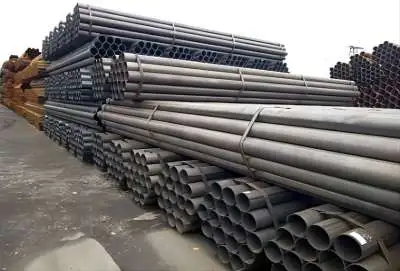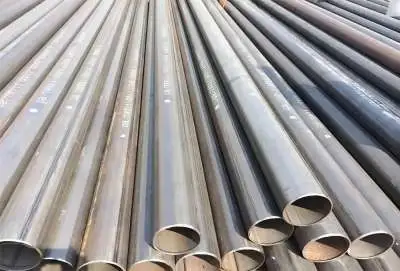The construction, oil and gas, and water transportation sectors all rely on steel pipes. Inside the domain of steel pipe producing, Electric resistance welding (ERW) and High frequency welding (HFW) pipe stand apart for their effectiveness and dependability.
ERW involves using electric resistance to weld steel sheets into pipes. It includes both direct current (DC) and alternating current (AC) techniques. However, in order to weld steel pipes, HFW uses high-frequency currents, typically between 100 and 600 kHz. This high-frequency welding technique produces high-quality welds that are suitable for a variety of applications and enables faster welding speeds.
When choosing the right pipe for a given application, it is essential to comprehend the distinctions between ERW and HFW. ERW pipes are flexible and broadly utilized for underlying applications and universally useful channeling because of their expense adequacy and simplicity of creation. In contrast, applications that require high-quality welds, such as oil and gas pipelines, where weld integrity is essential for operational reliability and safety, favor HFW pipes.
Picking either ERW and HFW steel pipes relies upon factors like task necessities, spending plan imperatives, and execution assumptions. Because of their distinct advantages, both methods are essential components of global industrial infrastructure.
|
|
|
ERW and HFW Welding Process:
ERW, short for Electric Resistance Welding, is a welding cycle where pressure is applied through cathodes after the weldment is gathered. By passing an electric flow through the joint contact surfaces and adjacent regions, this method induces the combination of metals by creating heat through obstruction. Straight crease welding is a typical application for ERW, which is known for delivering top notch welds that are urgent in businesses that require accuracy and strength.
High frequency welding , or HFW, is a specific type of ERW that generates heat by utilizing high-recurrence flows. The skin impact, which focuses high-recurrence current on the workpiece's surface, and the closeness impact, which coordinates the progression of high-recurrence current, are used in this cycle. Through expulsion, HFW rapidly warms and softens the edges of nearby steel plates, taking into consideration a consistent butt joint. HFW is ideally suited for applications that require quick creation and high throughput due to its speed and proficiency.
Because it is able to keep up with constant intensity dispersion, HFW benefits include improved weld honesty and efficiency. This method is preferred in industries like oil and gas, where pipeline integrity and longevity depend on the dependability of welded joints. By adhering to stringent standards like API 5L and ISO 3183, HFW ensures that welded steel pipes used in PSL2 applications have robust mechanical properties, resistance to corrosion, and long-term durability. Thus, HFW assumes an essential part in saving the viability and respectability of the foundation that is important for the worldwide transportation of hydrocarbons.
HFW is Required in API 5L PSL2 ERW Steel Pipe:
ERW steel pipes used in PSL2 applications must undergo HFW (High-Recurrence Welding) in accordance with API 5L and ISO 3183 specifications. Since PSL2 is a better quality for steel pipes, severe controls should be put on properties like durability, strength, and compound piece. Since it successfully resolves inborn issues like hardness, absence of combination, and weakness to stretch erosion breaking (SCC), the execution of HFW in PSL2 pipes is significant. These issues are pivotal for guaranteeing that the lines can endure the intense states of the oil and gas industry, particularly while shipping hydrocarbons over significant distances. HFW welding improves the structural integrity of the pipes, lowering the likelihood of defects and ensuring consistent performance in harsh environments. By adhering to these standards, manufacturers uphold the safety and reliability requirements for energy infrastructure. This makes it possible for hydrocarbons to be transported effectively and safely around the world.
ERW Steel Pipe Includes HFW Steel Pipe:
Electric Resistance Welding, or ERW for short, refers to a variety of welding techniques that join metals by applying electric resistance. There are two primary types of ERW to choose from: direct current welding and alternating current welding (AC). High-Frequency Welding (HFW) is a type of ERW that is specifically included in the AC category.
In order to generate heat for welding, HFW makes use of high-frequency currents, typically ranging from 100 to 600 kHz. Steel pipes, both regular and thin-walled varieties, can be made using this method best. Contact welding and induction welding are two methods used in HFW, and depending on the application and the properties of the material, each has its own set of advantages.
HFW steel pipes are a particular subset of ERW pipes known for their effective creation capacities and high weld quality. The utilization of high-recurrence flows considers fast and exact warming of the edges of steel plates, empowering consistent butt joints with negligible deformities. This results in strong, long-lasting welds that meet strict industry standards for pipeline construction and structural frameworks.
In synopsis, while ERW envelops a scope of welding strategies using electric opposition, HFW stands apart inside this classification for its use of high-recurrence flows, offering upgraded productivity and quality in the development of steel pipes.
HFW Steel Pipe Exporters:
Due to their cost-effectiveness, robust weld quality, and efficiency, HFW (High-Frequency Welded) steel pipes have gained a lot of popularity across industries. They are used broadly in applications going from oil and gas pipelines to primary systems because of their dependability and execution.
One conspicuous provider in this field is the Longma, known for conveying HFW steel pipes that stick to severe global guidelines. For oil and natural gas transportation, these include API 5L, ASTM A53, ASTM A500, ASTM A252 for piling, and ASTM A795 for fire protection systems. For general structural applications, ASTM A53 is also included.
The Longma separates itself through its obligation to quality confirmation and consumer loyalty. They guarantee that their HFW steel pipes meet or exceed industry standards, providing long-lasting options that can withstand challenging operational environments. Their products are made with precision using cutting-edge welding methods. This makes sure that the welds have high integrity, which makes installations more reliable and last longer.
The Longma Group can be reached via email at info@longma-group.com for inquiries and orders of HFW steel pipes that meet a variety of specifications. Their devoted client care group is accessible to give specialized help and backing all through the obtainment cycle, building up their standing as a trustworthy provider in the worldwide market for welded steel pipes.














